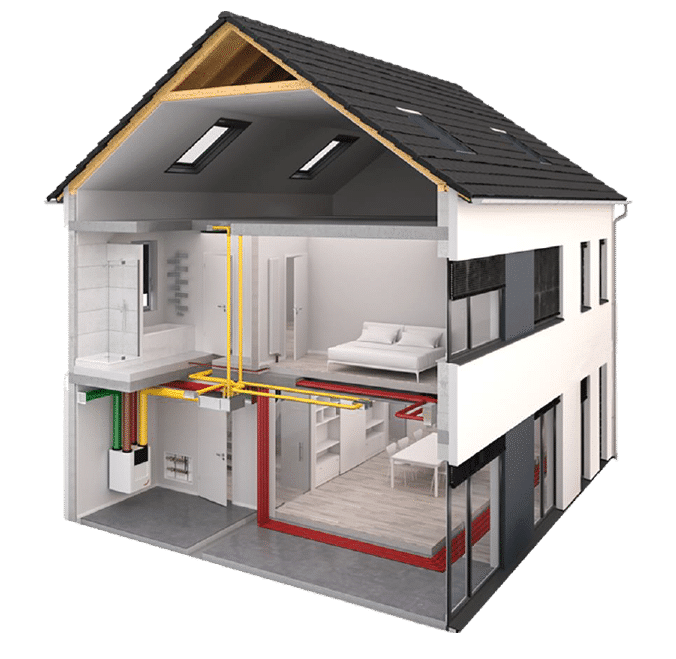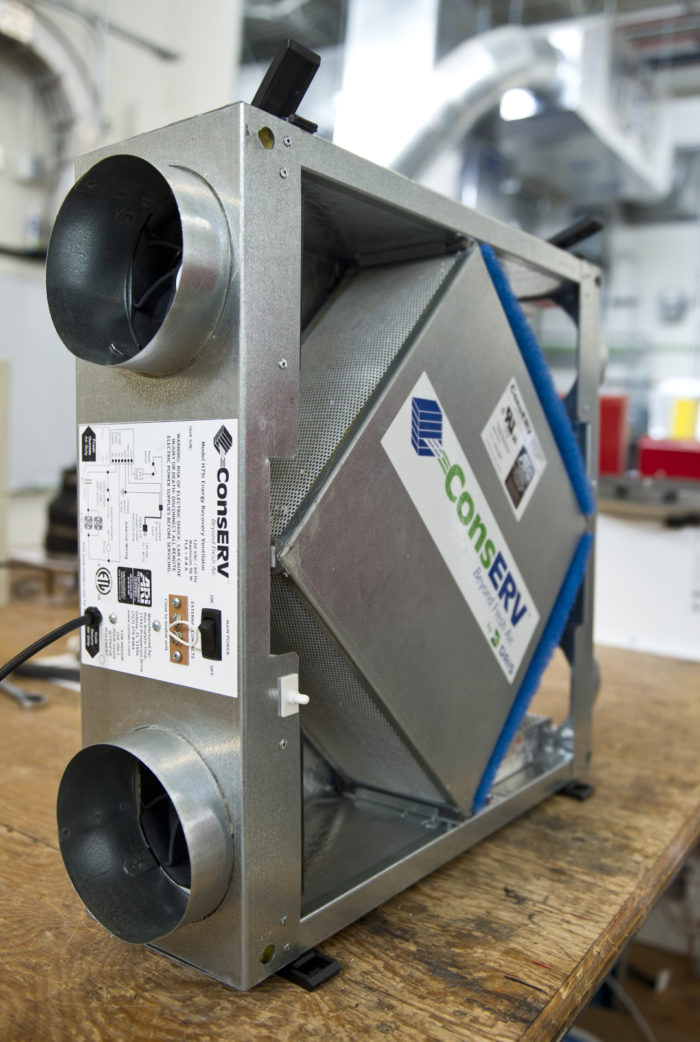Financial Benefits of HRV for Homeowners
Revealing the Trick Benefits and Uses of Heat Recovery Ventilation in Lasting Design
Heat Recovery Ventilation (HRV) systems play a vital function in sustainable style. They help with a continual exchange of stale indoor air with fresh exterior air, greatly enhancing interior air high quality. HRVs contribute to power efficiency by redeeming warm from exhausted air, which can reduce utility prices. Understanding the diverse advantages and applications of HRVs exposes their importance in modern-day architecture. What other benefits do these systems use in the search of sustainability?
Understanding Heat Recovery Ventilation Equipments
Heat recovery ventilation (HRV) systems are created to boost interior air quality while minimizing power loss. These systems utilize a mechanical ventilation approach to exchange stale indoor air with fresh exterior air, making sure a constant supply of tidy air. By capturing warmth from the exhaust air, HRVs precondition incoming air, decreasing the demand on home heating and cooling down systems. This process not just boosts thermal convenience however additionally adds to power effectiveness in property and industrial buildings. Furthermore, HRV systems help control moisture degrees and decrease indoor toxins, promoting a much healthier living environment. Their calculated application is necessary for attaining lasting layout objectives, as they provide a balance between energy conservation and occupant health.
Exactly How HRV Solution Job
While lots of might know with air flow systems, understanding just how warmth recovery ventilation (HRV) systems run is important for appreciating their benefits. HRV systems function by trading stagnant indoor air with fresh exterior air while transferring warm in between both streams. This process takes place in a heat exchanger, where warmth from the outward bound air warms the inbound air during chillier months, decreasing power loss. On the other hand, in warmer months, the system can cool incoming air using the cooler outward bound air. HRVs are equipped with fans to assist in airflow and filters to eliminate particulates, making certain a constant, well balanced air flow procedure. This ingenious design not only enhances energy effectiveness but likewise adds to maintaining a comfy interior atmosphere.
Enhancing Indoor Air High Quality
Indoor air quality can significantly impact health and wellness and wellness, making reliable ventilation crucial in modern-day homes. Heat Recovery Ventilation (HRV) systems play an important function in maintaining indoor air high quality by continually trading stale interior air with fresh exterior air. This procedure not only decreases airborne contaminants but also minimizes moisture degrees, which can bring about mold and mildew growth and breathing issues. HRV systems filter incoming air, getting rid of irritants and particulates, therefore giving a much healthier living environment. Furthermore, these systems aid get rid of smells and unpredictable natural substances (VOCs) typically found in house products. By ensuring a constant circulation of clean air, HRV systems add to a total improved interior environment, promoting comfort and wellness for occupants.
Power Effectiveness and Expense Cost Savings
Power performance stands apart as a considerable benefit of Heat Recovery Ventilation (HRV) systems. By recording and reusing the heat from exhausted interior air, HRVs lessen the energy needed for home heating incoming fresh air, resulting in decreased power usage. This efficiency translates into reduced utility costs, offering substantial price savings for property owners and organizations alike. In addition, HRV systems often get power efficiency rewards and rebates, additionally enhancing their economic charm. Gradually, the preliminary investment in HRV modern technology can result in a positive return on investment through lowered power expenses. The combination of HRV systems not only promotes lasting style but likewise offers a sensible solution for attaining long-lasting energy financial savings and financial advantages.
Environmental Advantages of HRV

A wide variety of ecological advantages develops from the implementation of Heat Recovery Ventilation (HRV) systems. By successfully transferring warm from exhaust air to inbound fresh air, HRVs significantly decrease the power needed for home heating and cooling down spaces. This energy effectiveness equates to decrease greenhouse gas emissions, contributing to a decline in the general carbon impact of structures. Furthermore, HRV systems enhance indoor air quality by continuously flowing fresh air, consequently minimizing the concentration of interior contaminants and irritants. Additionally, the decrease in energy usage help in preserving natural deposits, making HRVs a vital component of lasting layout. Overall, the ecological advantages of HRVs play an important function in promoting a healthier earth and fostering environment-friendly building techniques.
Versatile Applications in Modern Style
Heat recovery ventilation (HRV) systems are increasingly being incorporated into both property and commercial building tasks. In residential setups, HRVs boost indoor air high quality while maximizing power performance. At the same time, in commercial areas, these systems maximize air flow techniques, demonstrating their adaptability in modern-day building applications.
Residential Projects Integration
While modern-day design progressively stresses sustainability, the combination of heat healing ventilation systems in property projects has actually become a sensible option for boosting interior air high quality and energy efficiency. These systems efficiently move warmth from exhaust air to inbound fresh air, decreasing energy loss and minimizing heating or cooling down demands. In new builds and retrofits alike, warmth healing ventilation can be seamlessly included, offering property owners with a healthier living atmosphere while reducing energy costs. Additionally, with enhancing awareness of environmental effects, more engineers and building contractors are acknowledging the long-term benefits of these systems. Therefore, heat recuperation ventilation has come to be an essential component of lasting household layout, showcasing convenience and commitment to eco-friendly techniques.
Commercial Spaces Optimization
As modern-day industrial spaces advance to fulfill the demands of sustainability and performance, the implementation of warmth healing air flow systems becomes an essential strategy for optimizing indoor atmospheres. These systems facilitate the exchange of stale indoor air with fresh outside air while reclaiming warmth energy, significantly decreasing power consumption. This not just enhances convenience for residents yet also helps in decreasing operational expenses. Functional applications can be observed in offices, retail spaces, and educational establishments, where air quality and temperature level control are paramount. In addition, integrating heat recovery ventilation straightens with eco-friendly structure certifications, additionally promoting environmental responsibility. Inevitably, adopting such systems in business architecture not only contributes to sustainability objectives go to the website but also fosters much healthier, extra efficient spaces for users.
Integrating HRV Into Sustainable Design Practices
Incorporating heat recuperation air flow (HRV) systems into lasting layout practices provides significant benefits in power efficiency and interior air top quality. By using HRV, designers can create cost-effective remedies that not only minimize energy intake however likewise improve the general comfort of indoor atmospheres. This alignment with sustainability goals positions HRV as an essential part in modern architectural strategies.
Energy Efficiency Enhancement
By incorporating warmth recuperation ventilation (HRV) systems into sustainable style methods, designers and home builders can significantly improve power performance in modern buildings. HRV systems function by capturing warmth from outward bound stale air and transferring it to incoming fresh air, decreasing the power required for home heating or cooling indoor rooms. This process not just reduces reliance on typical HVAC systems yet additionally decreases overall power usage. On top of that, HRV systems can help preserve a constant indoor temperature, decreasing peak energy needs. By integrating these systems, structures can attain considerable decreases in energy costs and carbon impacts, aligning with sustainability objectives. Inevitably, HRV technology represents a practical service for improving energy performance in the developed go to this website environment, advertising more accountable resource usage.
Indoor Air Quality Enhancement
Exactly how can heat recuperation ventilation (HRV) systems add to remarkable indoor air quality in modern buildings? HRV systems effectively exchange stagnant indoor air with fresh outside air while recuperating warm energy, minimizing temperature changes. This procedure lowers the focus of indoor contaminants, such as unpredictable organic substances (VOCs), allergens, and wetness, which can degrade air high quality and impact occupant health. By maintaining suitable moisture levels and making certain a continuous supply of tidy air, HRVs help create a healthier interior environment. Furthermore, these systems can be integrated right into lasting design methods, advertising power efficiency along with boosted air high quality. HRV Heat Recovery Ventilation. Subsequently, HRV innovation plays an essential function ahead of time overall occupant convenience and well-being in modern building layouts
Affordable Design Solutions

Often Asked Concerns
What Upkeep Is Required for Heat Recovery Ventilation Solutions?

Upkeep for warm recuperation air flow systems normally includes routine filter replacements, cleansing of warmth exchangers, examination of fans and ducts, and ensuring appropriate drain. These jobs help preserve performance and lengthen the system's life-span with time.
Can HRV Solutions Be Installed in Existing Structures?
Heat recovery ventilation systems can certainly be installed in existing structures. HRV Heat Recovery Ventilation. Retrofitting needs careful planning and analysis of the building's design, making certain compatibility with present systems while optimizing energy effectiveness and interior air top quality
Exactly How Do HRV Systems Impact Sound Degrees Indoors?
HRV systems can affect indoor sound levels by presenting sound from external resources through ventilation. Nonetheless, premium installments typically incorporate sound-dampening features, minimizing sound effect while giving efficient air exchange and keeping comfort inside.
Are There Any Type Of Disadvantages to Utilizing HRV Solutions?
The disadvantages of utilizing HRV systems consist of potential high first prices, upkeep difficulties, and the possibility of decreased indoor air quality if filters are sporadically altered, which might bring about problems with moisture degrees.
How Do I Select the Right HRV System for My Requirements?
Selecting the ideal warm healing air flow system includes evaluating details demands, such as building size, environment, and power efficiency goals. In addition, examining system attributes, setup requirements, and maintenance factors to consider is important for peak performance and fulfillment.